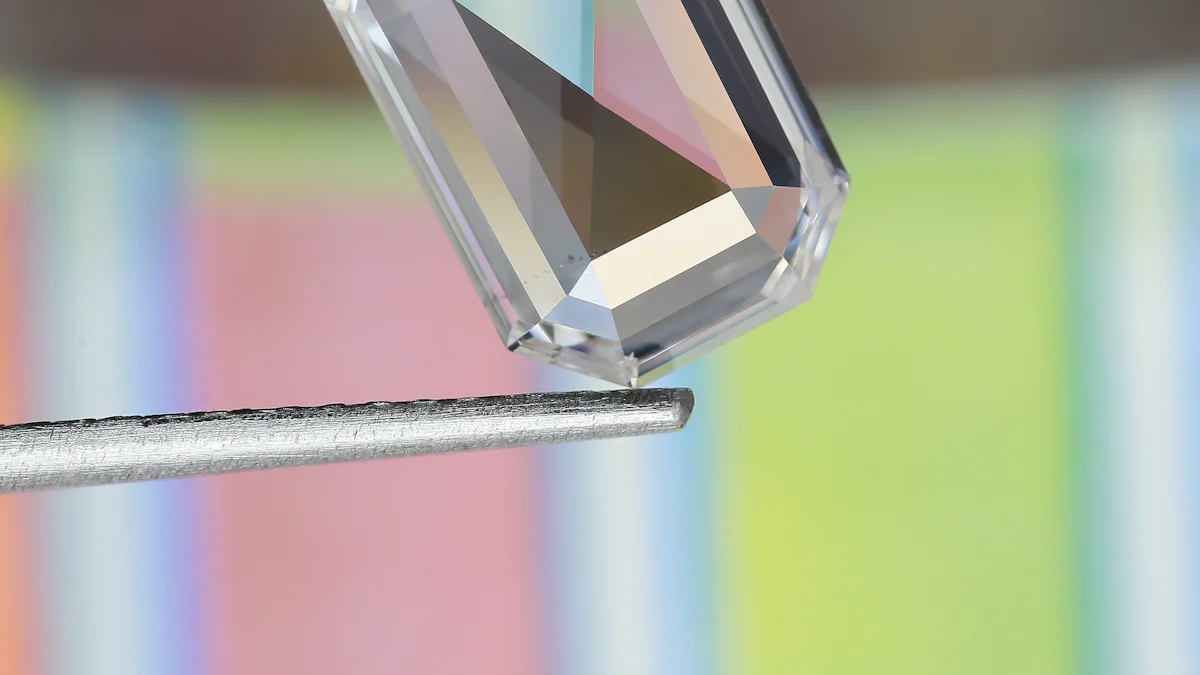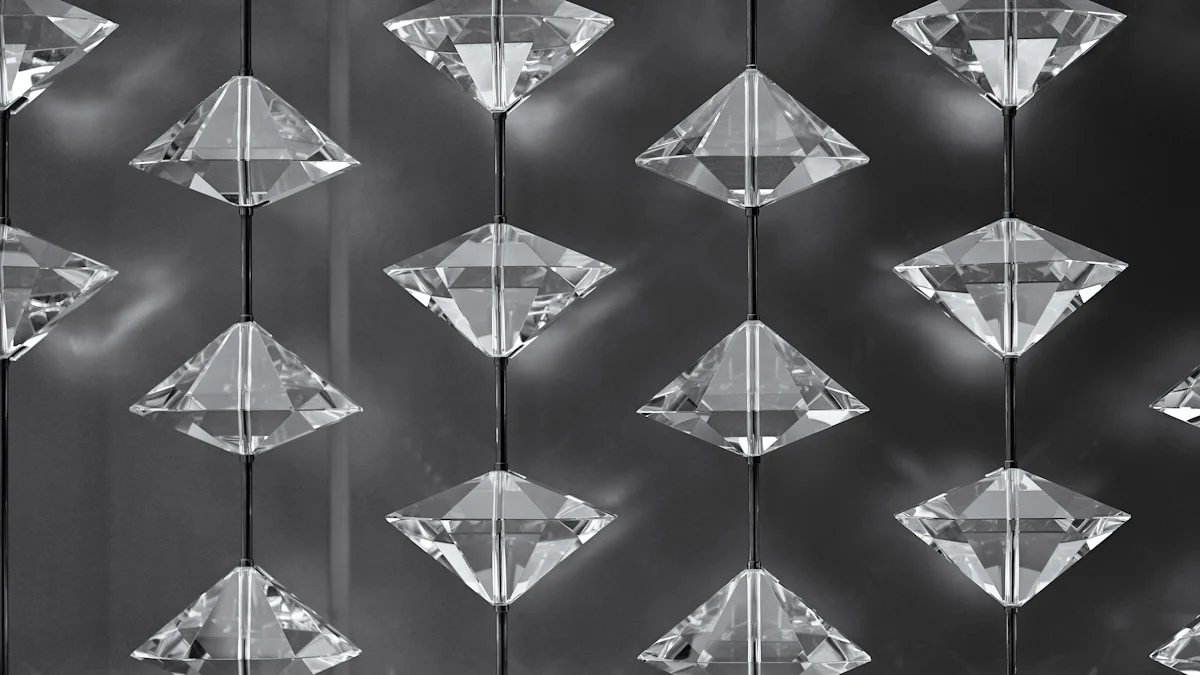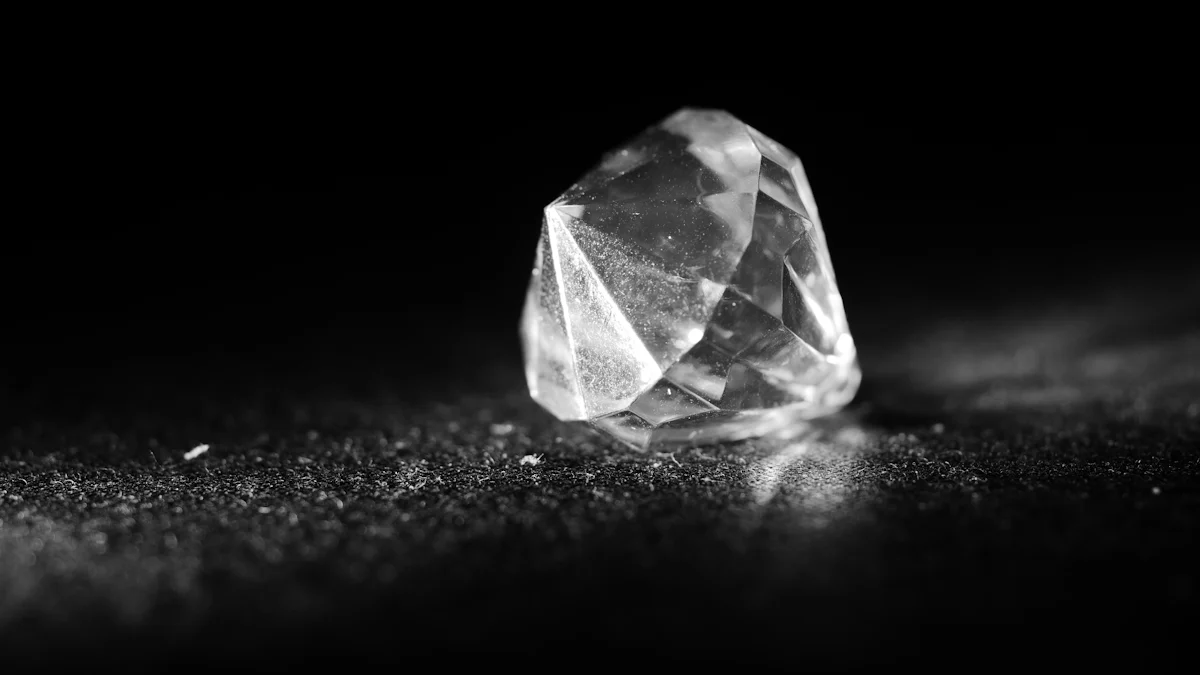Clarity for Diamonds Chart and Visual Grade Comparison

When buying diamonds, understanding clarity helps you make smarter choices. Clarity determines how flawless a diamond appears, directly affecting its beauty and worth. Higher clarity grades often mean fewer imperfections, which enhances the diamond's sparkle. This also significantly impacts price. For example, a diamond with SI2 clarity might cost $6,500, while a VVS1 diamond of similar size could cost $13,500—a 100% price jump for just a few grades. The clarity for diamonds chart simplifies comparisons, helping you balance visual appeal with your budget.
What Is Diamond Clarity?
Definition and Importance
Diamond clarity refers to the evaluation of a diamond's internal and external characteristics. The Gemological Institute of America (GIA) defines clarity as a grading system that assesses the presence of inclusions (internal features) and blemishes (external features). These imperfections are analyzed based on their size, number, position, relief, and type. The clarity grading system ranges from Flawless (FL) to Included (I3), providing a standardized way to compare diamonds.
Clarity plays a crucial role in determining a diamond's overall quality. Internal inclusions and surface blemishes can affect how light interacts with the diamond. Fewer imperfections allow more light to pass through, enhancing the diamond's brilliance and sparkle. For example, a diamond with a higher clarity grade will typically have fewer visible flaws, making it more visually appealing. However, not all imperfections are visible to the naked eye, so clarity grades also reflect how noticeable these flaws are under magnification.
To assign a clarity grade, experts examine the diamond under 10x magnification. They consider factors like the number and size of inclusions. Larger inclusions or those near the center of the diamond can significantly impact its appearance. Understanding clarity grades helps you make informed decisions when choosing a diamond that balances beauty and budget.
Factors That Influence Clarity Grades
Several factors determine a diamond's clarity grade. These include:
- Size: Larger inclusions have a more noticeable impact on clarity grades.
- Number: A higher number of inclusions can lower the clarity grade.
- Position: Inclusions near the center of the diamond are more visible and impactful.
- Nature: This refers to the type of imperfection, such as internal inclusions or external blemishes.
- Relief: The visibility of inclusions depends on how much they contrast with the diamond itself.
Inclusions and blemishes differ in their effect on clarity grades. Inclusions, like feathers or crystals, are internal features that can influence all clarity grades. Blemishes, such as polish lines or abrasions, are external and primarily affect diamonds in the top clarity grades. The location and visibility of these imperfections play a significant role in determining the final clarity grade.
By understanding these factors, you can better evaluate diamond clarity grades and choose a diamond that meets your expectations for beauty and value.
Diamond Clarity Chart and Grading Scale

Overview of the GIA Clarity Scale
The GIA clarity scale is the industry standard for evaluating diamond clarity. It categorizes diamonds into six main groups, each reflecting the visibility and impact of inclusions and blemishes. This scale ensures consistency and transparency in diamond grading. Below is a clarity grade chart summarizing the GIA clarity scale:
| Clarity Grade | Description |
|---|---|
| Flawless (FL) | No inclusions and no blemishes visible. |
| Internally Flawless (IF) | No inclusions visible but does have blemishes. |
| Very, Very Slightly Included (VVS1 and VVS2) | Inclusions so slight they are difficult for a skilled grader. |
| Very Slightly Included (VS1 and VS2) | Inclusions are observed with effort but can be characterized as minor. |
| Slightly Included (SI1 and SI2) | Inclusions are noticeable. |
| Included (I1, I2, and I3) | Inclusions are obvious which may affect transparency, brilliance, and durability. |
Flawless (FL) and Internally Flawless (IF)
Flawless diamonds have no inclusions or blemishes visible under 10x magnification. Internally flawless diamonds, on the other hand, may have minor surface blemishes but no internal inclusions. These grades represent the pinnacle of clarity and are extremely rare.
Very Very Slightly Included (VVS1 and VVS2)
Diamonds in this category have inclusions so tiny that even skilled graders find them challenging to detect under magnification. These inclusions are virtually invisible to the naked eye, making VVS diamonds highly desirable.
Very Slightly Included (VS1 and VS2)
VS diamonds contain minor inclusions that require effort to spot under magnification. These inclusions are small enough to have minimal impact on the diamond's brilliance and are an excellent choice for balancing quality and cost.
Slightly Included (SI1 and SI2)
Inclusions in SI diamonds are noticeable under magnification and may sometimes be visible to the naked eye. These diamonds offer good value for those prioritizing size or other factors over clarity.
Included (I1, I2, and I3)
Included diamonds have obvious inclusions that can affect their transparency, brilliance, and durability. These inclusions are visible without magnification and are typically less expensive.
How Clarity Grades Are Determined
Gemologists use a meticulous process to assign clarity grades. They rely on tools like microscopes and 10x loupes to examine diamonds. The process involves several steps:
- Magnification: Experts inspect the diamond under 10x magnification to identify inclusions and blemishes.
- Lighting and Background: Proper lighting and a neutral background enhance the visibility of imperfections.
- Expert Eye: Gemologists map inclusions based on size, number, position, color, and nature.
- Clarity Grade Assignment: The diamond receives a clarity grade based on these observations.
- Consistency in Grading: Multiple experts may evaluate the diamond to ensure accuracy.
Evaluating with gemological accuracy generally requires a microscope, another GIA contribution to the industry. GIA’s standard is that clarity, polish, and symmetry grading can only be finalized using a 10x loupe.
The GIA clarity scale, established in 1953, revolutionized diamond grading by introducing consistent terminology and categories. Before this, terms like "perfect" were used ambiguously. Today, the scale includes six categories and 11 specific grades, making it easier for you to compare diamonds using tools like the clarity for diamonds chart.
Diamond Clarity Comparison: Visual Differences

Clarity Grades and Naked Eye Visibility
FL/IF vs VVS1/VVS2
When comparing FL/IF diamonds to VVS1 and VVS2 diamonds, the visual differences are minimal. Flawless and Internally Flawless diamonds have no visible inclusions or blemishes under 10x magnification. VVS diamonds, including VVS1 and VVS2 clarity grades, contain inclusions so tiny that even skilled graders struggle to detect them under magnification. To the naked eye, these grades appear identical, making VVS diamonds an excellent alternative to FL/IF diamonds for those seeking high clarity without the premium price tag.
VVS1/VVS2 vs VS1/VS2
The difference between VVS diamonds and VS diamonds lies in the size and visibility of inclusions. VVS diamonds, such as VVS1 and VVS2, have inclusions that are nearly impossible to spot without magnification. In contrast, VS diamonds, including VS1 and VS2 clarity grades, feature minor inclusions that require effort to see under 10x magnification. These inclusions are still invisible to the naked eye, making VS diamonds a popular choice for balancing quality and cost. When comparing vvs vs. vs1 diamonds, the visual differences remain negligible unless viewed under magnification.
VS1/VS2 vs SI1/SI2
The transition from VS diamonds to SI diamonds introduces noticeable changes. VS1 and VS2 diamonds maintain their "eye clean" appearance, with inclusions only visible under magnification. SI diamonds, including SI1 and SI2 clarity grades, often have inclusions that may be visible to the naked eye, depending on the diamond's cut. SI1 diamonds typically offer better clarity than SI2 diamonds, but both provide excellent value for those prioritizing size or other factors over clarity.
The Role of Magnification in Clarity Assessment
Magnification plays a crucial role in assessing diamond clarity. Gemologists use 10x magnification to identify inclusions and blemishes that are invisible to the naked eye. This process ensures accurate grading by revealing intricate details, much like using a magnifying glass to examine fine print. The diamond clarity chart reflects this standard, with grades ranging from Flawless to Included based on visibility under 10x magnification. Without magnification, inclusions in grades like VVS2 clarity or VS2 clarity might go unnoticed, highlighting the importance of professional evaluation.
Tip: While magnification helps experts grade diamonds, you can focus on how the diamond looks to the naked eye to find the best balance between clarity and budget.
How Clarity Impacts Price and Value
Clarity and Pricing Trends
Clarity plays a significant role in determining the price of diamonds. Higher clarity grades often command premium prices due to their rarity and visual appeal. For example, a 1.00-carat round diamond with SI2 clarity costs approximately $6,500, while a similar diamond with VVS1 clarity is priced at $13,500. This represents a 100% price increase for just a few clarity grades. Internally Flawless (IF) diamonds are even more expensive, reflecting their exceptional quality.
| Clarity Grade | Price (Approx.) | Price Difference |
|---|---|---|
| SI2 | $6,500 | - |
| VVS1 | $13,500 | $7,000 |
| IF | Higher | Even more |
When choosing a diamond, understanding these pricing trends helps you make informed decisions. You can balance clarity with other factors to find the best value for your budget.
Balancing Clarity with Cut, Color, and Carat
Clarity is just one of the 4 Cs that determine a diamond's overall quality. To get the best value, you should balance clarity with cut, color, and carat weight.
- A diamond's cut can enhance its clarity by improving how light reflects within it.
- Sometimes, a diamond with a lower clarity grade but better color can appear more beautiful.
- If you prefer a larger carat weight, consider a higher clarity grade to maintain visual appeal.
- Focus on the cut first, as it significantly impacts brilliance.
- Evaluate color and clarity together to ensure the diamond looks flawless to the naked eye.
- Choose a carat size that fits your preferences and budget.
Balancing these factors ensures you select a diamond that offers both beauty and value.
When to Prioritize Clarity
You should prioritize clarity when visual flawlessness is essential. Higher clarity grades, like VVS1 or IF, have fewer inclusions, allowing more light to pass through. This enhances the diamond's sparkle and brilliance. Viewing diamonds under different lighting conditions, such as sunlight or office lighting, helps you assess their true clarity.
If you’re choosing a smaller diamond or a simple setting, clarity becomes more noticeable. In these cases, investing in a higher clarity grade ensures the diamond looks stunning in all environments.
Tips for Choosing the Right Clarity Grade
Budget Considerations
Your budget plays a crucial role in selecting the right clarity grade. Diamonds with higher clarity grades, such as VS1 or above, often come with a premium price tag. However, you can find excellent options in the VS2 or SI1 range that balance quality and cost. These clarity grades are typically "eye-clean," meaning inclusions are not visible to the naked eye.
To optimize your budget, consider prioritizing other factors like color or cut over clarity. Clarity imperfections have less impact on a diamond's brilliance compared to poor color or cut. For example, a well-cut diamond with an SI1 clarity grade can still sparkle beautifully.
Here’s a quick look at price ranges for different clarity grades:
| Clarity Grade | Lab-Grown Price Range | Natural Price Range |
|---|---|---|
| VS1 | $1,500 - $4,000 | $5,000 - $50,000 |
| SI1 | $700 - $1,500 | N/A |
| SI2 | $500 - $1,500 | N/A |
| Fancy Colors | $2,000 | N/A |
Diamond Size and Setting
The size of the diamond significantly affects the visibility of inclusions. Larger diamonds have bigger facets, which make imperfections more noticeable. If you’re shopping for a larger diamond, consider a higher clarity grade to minimize visible flaws. For smaller diamonds, inclusions are less apparent, allowing you to choose a lower clarity grade without sacrificing visual appeal.
The setting of the diamond also plays a role in masking imperfections. Certain settings, like halo or bezel designs, can hide small inclusions effectively. This allows you to select a lower clarity grade while maintaining the diamond's overall beauty.
When Lower Clarity Grades Are a Smart Choice
Lower clarity grades can be a smart choice in specific situations. If you prioritize carat weight or a unique cut over clarity, opting for a diamond with SI1 or SI2 clarity grades can help you stay within budget. These grades often look flawless in jewelry like earrings or pendants, where diamonds are not viewed up close.
For those seeking larger diamonds at a lower price, an I2 clarity diamond might be worth considering. While it may have visible imperfections, it offers a more affordable option for achieving a bigger size.
Tip: Always evaluate how the diamond looks in person. Lighting and distance can influence how noticeable inclusions appear.
Understanding diamond clarity is essential for selecting a visually stunning diamond that fits your budget. Higher clarity grades, like IF and VVS, enhance brilliance by minimizing visible inclusions, while lower grades, such as I2 and I3, often compromise a diamond's aesthetic appeal. Certain shapes, like emerald cuts, demand higher clarity to maintain their beauty, while brilliant cuts can mask imperfections effectively.
Use the clarity for diamonds chart to compare grades and make informed decisions. Focus on eye-clean options, such as VS2 to SI2, and evaluate diamonds under different lighting. Balancing clarity with cut, color, and carat ensures you find a diamond that aligns with your style and budget.
FAQ
What does "eye-clean" mean in diamond clarity?
"Eye-clean" refers to diamonds with inclusions that are invisible to the naked eye. These diamonds appear flawless without magnification, making them a popular choice for balancing clarity and cost.
How does diamond size affect clarity visibility?
Larger diamonds make inclusions more noticeable due to their bigger facets. For larger stones, choosing a higher clarity grade ensures fewer visible imperfections.
Is it worth paying extra for flawless clarity?
Flawless diamonds are rare and expensive. However, most inclusions in lower grades like VS1 or VS2 are invisible to the naked eye. You can save money by choosing these grades without sacrificing visual appeal.
Can diamond settings hide clarity imperfections?
Yes, certain settings like halo or bezel designs can mask inclusions. These settings allow you to choose diamonds with lower clarity grades while maintaining their beauty.
How does clarity impact a diamond's sparkle?
Fewer inclusions allow more light to pass through the diamond, enhancing its brilliance. Higher clarity grades typically result in better sparkle, but cut quality also plays a significant role.
See Also
A Comprehensive Guide to Engagement Ring Diamond Cuts
Comparing Leading Brands for White Diamond Rings
Price Comparison of All Around Diamond Rings

